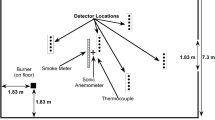Abstract
An analog light-scattering-type smoke detector was tested in a wind tunnel at various low velocities. The air flow in the wind tunnel contained an aerosol concentration that resulted in a high ambient optical density, simulating smoke well above threshold optical detector density. The objective of this research was to determine the lag time to alarm, Δt, associated with difficulty of smoke entry into a detector. A “critical velocity” was identified for the smoke detector, below which the lag time increased exponentially with decreasing velocity. Increased lag time results in the detector responding unacceptably late—or not at all—even when ambient obscuration is well above limits defined in UL standard tests.
A preliminary method for placing smoke detectors has been developed, based on a user-defined design fire size and the detector aerosol-entry lag time. The preliminary method applies only to flaming fires producing smoke, with the detector far from a wall and mounted on smooth ceilings. The critical velocity value used in the examples in this paper applies only to the smoke detector configuration tested in this work, at the evaluated sensitivity setting, with the optical densities reached using the generated artificial smoke. Any variation in detector housing, design, operation principle, or application with different aerosols requires specific tests to determine a different critical velocity.
This paper provides the basis for further development of a smoke detector placement method based on a design fire size and the proposed detector critical velocity concept. It does not presume to report a unique “critical velocity” for all smoke detectors, but suggests that such a value may indeed exist, but with differing values among different smoke detectors.
Similar content being viewed by others
References
Heskestad, G., “Characterization of Smoke Entry and Response for Products-of-Combustion Detectors,”Fire Detection for Life Safety: Proceedings of a Symposium (March 31 and April 1, 1975), National Academy of Science, Washington, 1977, pp. 93–127.
NFPA 72E,Standard for Automatic Fire Detectors National Fire Protection Association, Quincy, Mass., 1990.
Heskestad, G. and Delichatsios, M. A., “Environments of Fire Detectors Phase II; Effect of Ceiling Configuration,” Volumes I and II,NBS-GCR-78-128, andNBS-GCR-78-129, June 1978(a).
Beyler, C. L., “A Design Method for Flaming Fire Detection,”Fire Technology Volume 20, Number 4 (1984), pp. 5–16.
Alpert, R. L., “Calculation of Response Time of Ceiling-Mounted Fire Detectors,”Fire Technology Volume 8 (1972), pp. 181–195.
Evans, D. D., “Ceiling-Jet Flows,”SFPE Handbook of Fire Protection Engineering NFPA, Quincy, Mass. 1988, pp. 1-138–1-145.
Beyler, C. L., “Fire Plumes and Ceiling-Jets,”Fire Safety Journal Volume 11 (1986), pp. 53–75.
Heskestad, G. and Delichatsios, M. A., “The Initial Convective Flow in Fire,”Proceedings of the 17th International Symposium on Combustion, Combustion Institute, Pittsburgh, Pa., 1978(b), pp. 1113–1123.
Motevalli, V. and Marks, C. H., “Characterizing the Unconfined Ceiling-Jet Under Steady State Conditions: A Reassessment,”Proceedings of the Third Fire Safety Science Symposium Elsevier Pub., New York, 1991, pp. 301–312.
Cooper, L. Y.,Journal of Heat Transfer Volume 104 (1982), p. 446.
Atreya, A., “Convection Heat Transfer,”SFPE Handbook of Fire Protection Engineering NFPA, Quincy, Mass., 1988, pp. 1-65–1-91.
Bright, R. G., “Recent Advances in Residential Smoke Detectors,”Fire Journal Volume 69, Number 6 (November 1974), pp. 69–77.
Marrion, C. E., Custer, R. L. P., and Motevalli, V., “Development of a Performance-Based Design Model to Characterize the Inherent Lag Time of Aerosol Entrance into Optical Smoke Detectors,” presented at the SFPE Meeting in San Antonio, Texas, May 1990.
Björkman, J., Kokkala, M. A., and Ahola, H., “Measurements of the Characteristic Lengths of Smoke Detectors,”Fire Technology Volume 28, Number 2 (1992), pp. 99–109.
Brozovsky, E. L.,A Preliminary Approach to Siting Smoke Detectors Based on Design Fire Size and Detector Aerosol Entry Lag Time Master's Project at Worcester Polytechnic Institute, Worcester, Mass., 1991.
UL 217,Standard for Single and Multiple Station Smoke Detectors, third edition, 1985, with updates through February 27, 1989, Underwriters Laboratories, Inc., Northbrook, Ill.
UL 268,Standard for Smoke Detectors for Fire Protective Signaling Systems, Third edition, 1989, with updates through May 2, 1989, Underwriters Laboratories Inc., Northbrook, Ill.
Author information
Authors and Affiliations
Rights and permissions
About this article
Cite this article
Brozovsky, E., Motevalli, V. & Custer, R.L.P. A first approximation method for smoke detector placement based on design fire size, critical velocity, and detector aerosol entry lag time. Fire Technol 31, 336–354 (1995). https://doi.org/10.1007/BF01039324
Issue Date:
DOI: https://doi.org/10.1007/BF01039324




